Abstract
Fire extinguisher inspectors face ergonomic risk factors and are exposed to several musculoskeletal disorders (MSDs). The aim of this study was to design and evaluate a mobile lift device to reduce the risk of musculoskeletal injuries among fire extinguisher inspectors. This was followed by a quasi-experimental trial among 28 workers, using surface electromyography (EMG), in which muscle activity with percentage of maximum voluntary contraction (MVC), postural analysis using the Rapid Entire Body Assessment (REBA), perceived exertion, and perceived ease of use among workers were evaluated during the fire extinguisher inspection process employing a manual fire extinguisher and using a mobile lift device. The results of the EMG measurement of the muscle activity in the biceps brachii, triceps brachii, middle deltoid, and upper trapezius were obtained using the MVC parameter. The MVC parameter was employed to normalize the EMG signals, allowing for a standardized comparison of muscle activation levels across different tasks and conditions. The results showed a significant positive effect on the muscle activity of the middle deltoid and biceps brachii; the posture risk level and rating for perceived exertion with the mobile lift device were generally lower than those of manual lifting (p < 0.001). With the mobile lift device, there was significant reduction in the muscle activity of the triceps brachii and upper trapezius (p < 0.05). Accordingly, mobile lift devices were found to be useful due to the reduced muscle effort, and postural risks were reduced when using the mobile lift device. Further studies are needed for modifications to the lift assist device based on ergonomic measures of muscle activity and user tests by adjusting the task to suit the capabilities of workers.
1. Introduction
Fire extinguishers are safety devices widely used to extinguish fires in the workplace and in the household [1]. Fire extinguisher inspection is a critical component of emergency preparedness and fire safety management in buildings and facilities. In Thailand, fire safety regulations are governed by the Building Control Act, B. E. 2522 (1979) [2,3]. The Notification of the Ministry of Industry Re: Fire Protection and Settlement in Factory, B. E. 2552 (2009), requires that the extinguisher should have at least a 4.5 kg agent capacity and must be readily available at all times; inspection of the equipment should be carried out at least once per month. Fire protection systems and equipment must be tested and maintained for ready use at all times [4]. These activities are performed manually by industrial workers.
However, manual fire extinguisher inspection involves the frequent lifting of heavy equipment, often with awkward body postures [5,6,7]. These work characteristics represent significant ergonomic risk factors that can lead to musculoskeletal disorders (MSDs), particularly in the lower back. Statistics from Great Britain from 2023 to 2024 reported that more than 543,000 workers suffered from work-related MSDs, with an estimated 7.8 million working days lost due to work-related musculoskeletal problems. The primary factors cited as causing work-related MSDs were manual handling, working in awkward or tiring positions, and keyboard or repetitive work [8]. Previous studies have consistently demonstrated high rates of musculoskeletal disorders among workers involved in manual material handling [5,9]. Tahernejad et al. [10] reported a high prevalence of MSDs among firefighters with their higher exposure to specific job-related risk factors of MSDs than other professions. Similarly, So et al. [11] mentioned that manual heavier load weight could increase the risk of low back pain (LBP). Work-related musculoskeletal disorders (WMSDs) represent a substantial burden on workers’ health and organizational productivity, with fire extinguisher inspectors being particularly vulnerable due to the repetitive nature of their work [10]. The physical demands of handling fire extinguishers during inspections often involve awkward postures, repetitive movements, and sustained muscular effort, which are well-established risk factors for MSDs [6]. Fire extinguisher inspectors often lift and maneuver heavy fire extinguishers, which can lead to strain on the lumbar spine. Previous research has demonstrated that intervention strategies focusing on ergonomic device implementation can significantly reduce the biomechanical load on workers [12,13,14].
However, limited attention has been paid to developing specific solutions for fire extinguisher inspection tasks. This study addresses this gap by evaluating a proposed mobile lift device aimed at reducing musculoskeletal injury risks among fire extinguisher inspectors. These findings highlight the critical need for ergonomic interventions in manual fire extinguisher inspection tasks.
2. Materials and Methods
2.1. Participants
In this study, a quasi-experimental trial was conducted with 28 fire extinguisher inspectors. The analysis compared traditional manual handling methods with a newly designed mobile lift device. The sample size was estimated using the mean difference in maximum voluntary contraction (MVC) among industrial workers in a study by Niyomphant [15]. According to the literature review, 5% relative accuracy is desired for the significance level and 95% corresponding to the power of the test. It was found that the minimum sample size for this study should be 25 participants. To avoid dropout, an attrition rate of 10% was applied, and the ultimate sample size reached 28 subjects.
The participants had a mean age of 29.89 years (standard deviation [SD] = 5.01) and no musculoskeletal deformities or injury to the upper-body extremities. All participants had been recruited on the inclusion criterion indicating that their experience in fire extinguisher inspection must be held for at least one year. Before taking part in the trial, the purpose of the study was explained to the participant. Informed consent was obtained from all participants.
2.2. Design of a Mobile Lift Device
This study was conducted in two phases. The first phase comprised designing and developing a prototype of a mobile lift device with the application of ergonomics principles. Relevant issues included work-related anthropometric data, working postures, material handling, heavy work, safety, and health. The second phase validated the manner of handling the proposed prototype to minimize worker effort and to improve working conditions related to musculoskeletal injuries.
2.2.1. Phase 1: Prototype Development of the Mobile Lift Device as Shown in Figure 1 Prototype Design
This experiment included one independent variable, which was the lifting technique, with manual lifting and the use of a mobile lift device.
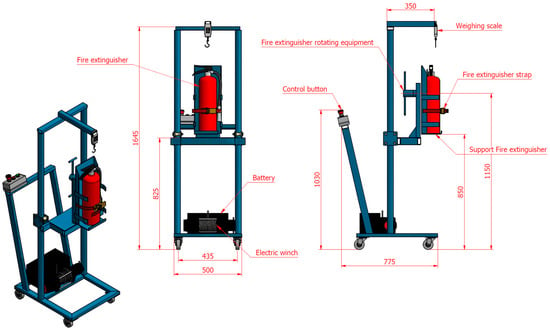
Figure 1.
A mobile lift device prototype.
2.2.2. Phase 2: Prototype Evaluation of the Mobile Lift Device
Surface electromyography (EMG) signals were recorded during the experimental using an eegoTM amplifier (EE-223, revision no. 1.2, eemagine Medical Imaging Solutions GmbH, Berlin, Germany). Four channels were used to simultaneously record the EMG activity of four muscles—the upper trapezius, the biceps brachii, the triceps brachii, and the middle deltoid. These muscles were chosen based on their relation to the manual lifting task used by Kong et al. [13]. The electrodes were placed on the muscles according to the reviewed literature [16,17].
Muscle Activity: Bipolar surface electrode placement (disposable Ag/AgCl) with a 2 cm interelectrode distance was carried out as in a previous study [18]. Preparation: Prior to electrode placement, the skin over the muscles was cleaned to remove any oils or contaminants that could interfere with signal quality. Electrode Placement: The bipolar surface electrodes were placed according to standardized anatomical landmarks. The root mean square (RMS) values of the surface EMG data (millivolts) of all the muscles were determined for muscle strength and fatigue. Three MVC efforts were performed for each muscle for five seconds with three repetitions. In all the tests performed, pressure and resistance were applied by the participants to the respective muscle tendons. Average RMS values were considered for the subsequent normalization of the muscles. The collected EMG signals were analyzed to determine muscle strength and fatigue levels. The RMS values provided insights into the electrical activity of the muscles during the exertion phases.
Ergonomic Observational Risk Assessment: The Rapid Entire Body Assessment (REBA) was used in the postural analysis for all participants when lifting fire extinguishers. A snapshot from video recordings was reviewed to analyze worker postures. The selection of postures for assessment prioritized the most challenging postures, work tasks, or instances in which the highest force load occurred. The REBA method assesses various body segments, including the neck, trunk, legs, upper arms, lower arms, and wrists. Each body part is assigned a score based on its position relative to a neutral posture. There were five action levels for risk estimation (0 = negligible, 1 = low, 2 = medium, 3 = high and 4 = very high) [19]. Before collecting data, the researchers were trained by advisors who were familiar with the REBA technique. Their expertise ensured that the assessments were conducted systematically and that the results were reliable for making informed decisions about workplace ergonomics.
To assess the user experiences when performing with a mobile lift device after they had finished lifting, the participants were requested to self-report their rate of perceived exertion (RPE) and ease of use between the different methods. Participants rated the manual method as easier to use, despite its higher physical demands. This preference likely stems from familiarity with the manual approach and its straightforward nature, which contrasts with the perceived complexity. The score was categorized into a five-point Likert scale ranging from 1 to 5 (1 = strongly disagree, 5 = strongly agree) for RPE and (1 = very easy, 5 = very difficult) for ease-of-use rating [20,21].
This study conducted an inspection of dry chemical fire extinguishers, which weigh approximately 9–12 kg per tank. The inspection process is crucial to ensure that the fire extinguishers are in a condition that allows them to function effectively in the event of a fire. The inspection steps include checking the external condition of the tanks, such as ensuring there are no cracks or damage, verifying that the pressure gauge indicates a green zone, and inspecting the hoses for any blockages.
All the participants were randomly divided into two fire extinguisher inspection groups for the experimental trial: (A) manual fire extinguisher and (B) using a mobile lift device. Each technique was conducted for 20 fire extinguishers. Before starting the experimental trial, the participants were trained in practical lifting techniques and how to inspect fire extinguishers to avoid errors (Figure 2). The steps for inspecting a fire extinguisher using a mobile lifting device can be described as follows:
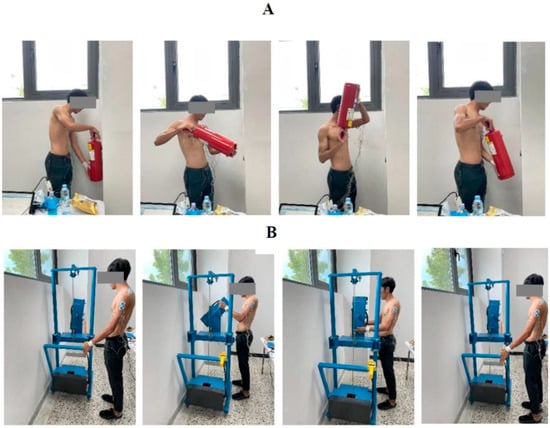
Figure 2.
(A) Manual fire extinguisher inspection. (B) Using a mobile lift device for fire extinguisher inspection.
- Approach the Fire Extinguisher: Begin by maneuvering the lifting device close to the fire extinguisher. Ensure that the device is positioned correctly to facilitate easy lifting.
- Lift the Fire Extinguisher: Press the button on the lifting device to raise the fire extinguisher from its hanging bracket. This action should be smooth and controlled to avoid any damage.
- Lock the Fire Extinguisher: Once the extinguisher is lifted, engage the locking mechanism on the device to secure the extinguisher in place. This ensures that it remains stable during the inspection process.
- Move the Extinguisher Away from the Wall: Carefully push the lifting device to move the fire extinguisher away from the wall.
- Rotate the Fire Extinguisher: Grasp the handle of the extinguisher and tilt it to turn it upside down.
- Weigh the Fire Extinguisher: Use a scale to check the weight of the extinguisher. This step is important to ensure that it is full and has not lost any extinguishing agent.
- Lift to Lock Position: Press the button again to lift the extinguisher to the designated locking point on the device.
- Return to Installation Position: Push the lifting device back to the original installation location of the fire extinguisher. Ensure that the path is clear and safe for movement.
- Unlock and Rehang the Fire Extinguisher: Finally, unlock the extinguisher from the lifting device and hang it back onto its bracket. Ensure that it is properly secured and ready for use.
- Remove the Lifting Device: Once the extinguisher is safely in place, maneuver the lifting device away from the area, completing the inspection process.
2.3. Statistical Analysis
The data analysis was conducted using the Statistical Package for the Social Sciences (SPSS). Descriptive statistics were used to analyze the participants’ characteristics, MVC, REBA score, RPE, and ease-of-use rating. A paired t-test was then performed to determine the effects of manual lift versus mobile lift device (A vs. B) on the dependent variables with a 95% confidence interval.
3. Results
3.1. Muscle Activity
According to the comparison results, the result of paired t-test indicated that manual lifting (A) required significantly higher exertion levels (% MVC) in the middle deltoid and biceps brachii compared with the mobile lift device (B) (p < 0.01). There was a significant preference towards the muscle activity of the triceps brachii and upper trapezius of the mobile lift device (p < 0.05), as shown in Figure 3.
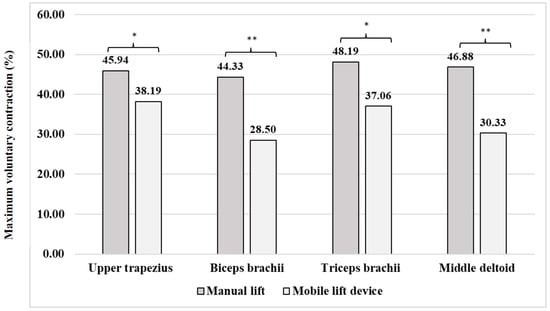
Figure 3.
Muscle activity while operating a fire extinguisher inspection task categorized by lift methods. * p < 0.05, ** p < 0.01.
3.2. Postural Analysis
There was a significant difference in the working posture, which was higher for manual lifting (A) than the mobile lift device (B) (p < 0.01), as shown in Figure 4.
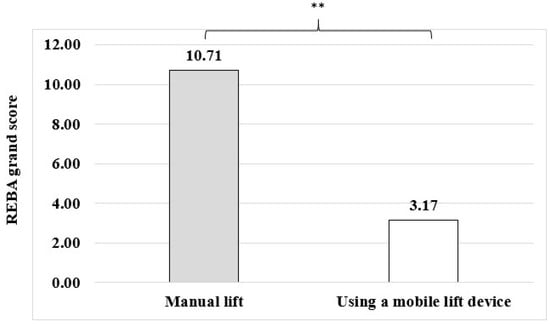
Figure 4.
Mean REBA risk score with two methods of fire extinguisher inspection. ** p < 0.01.
3.3. Perceived Usability
A comparison of the RPE between methods A and B was determined. The findings indicated that the users’ perceived exertion was lower when interacting with method B than with method A (p < 0.01), as shown in Figure 5.
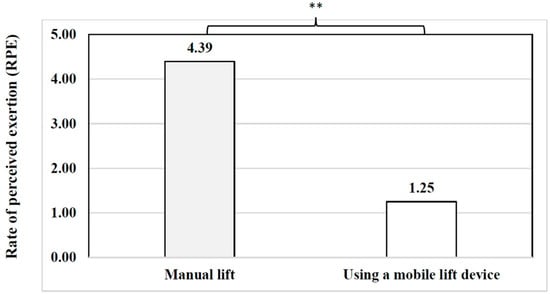
Figure 5.
Rate of perceived exertion (RPE) with two methods of fire extinguisher inspection. ** p < 0.01.
A comparison of the mean ease-of-use ratings between methods A and B was conducted. The results revealed that the users’ perceived ease of use was lower when interacting with method B than with method A (p < 0.01), as shown in Figure 6.
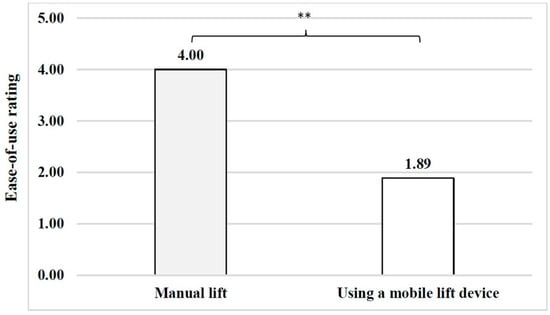
Figure 6.
Ease-of-use rating with the two methods of fire extinguisher inspection. ** p < 0.01.
4. Discussion
Ergonomics is an important part of occupational health and safety. It aims to promote health, efficiency, and well-being in employees by designing safe, satisfying, and productive work [22]. Manual material handling (MMH) is the most common cause of work-related musculoskeletal injuries [14]. In this study, a mobile lift device was proposed to help firefighters with extinguisher inspections. The results showed that a mobile lift device had a significant effect on the activity of each muscle. When performing the fire extinguisher inspection task with the mobile lift device, the muscular activity (% MVC) of all muscle groups was generally lower than with manual lifting. This is consistent with the reduction in muscle activity observed by Kong et al. [13], who found that a lift assist device for worker posture and muscle load for transferring tasks can reduce the physical workloads compared to traditional lifts.
Previous studies have also assessed muscle activity levels when performing with lift assist devices [12,23,24,25]. They reported that the muscles showed less physical and perceived stress when using lift assist devices. Using a lifting device reduces the exposure associated with manual handling and reduces the need for workers to bend, strain, and lift heavy loads. It is possible that a neutral working posture may be achieved when lifting the fire extinguisher while using a lifting device. This is consistent with the ergonomics postural analysis using REBA in this study, which found that typical manual fire extinguisher inspection showed higher risk levels, which were reduced by the use of a mobile portable device. It is possible that the initial lifting effort in the bending posture forced the operator to bend more with the torso of the body while carrying the load. Previous studies by Janice [26] and Bernard [25] reported that inappropriate posture increases the risk of injury during maintenance activities.
It is important to note that the risk factors associated with manual lifting are the amount of weight being lifted and the awkward posture of workers, requiring maintenance of muscle force over an extended period of time [27]. Fire extinguisher inspection can be made safer by providing proper equipment to operators, thereby reducing the force acting on the musculoskeletal system, especially in the lumbar region [25]. There is a need for prevention programs for industrial work, as well as a need to improve the work conditions to suit the workers. For this reason, it is appropriate that this study found that a lifting device reduces muscle exertion, reducing the risk of muscle injury.
The results of this study indicate that the users’ perceived exertion was lower when using a mobile lift device than with a manual lift. This is consistent with the users’ perceived ease-of-use assessment. The results revealed that a mobile lift device seems to provide more ease of use than manual lifting. The users’ experiences when using a mobile lift device were perceived as satisfying.
The proposed ergonomic device proved to be suitable in terms of comfort and applicability for workers. These findings support the conclusions of previous studies, which showed that using an assistive lift device increased user comfort and satisfaction [5,7,13]. Graham [28] reported that ratings of perceived exertion of lift assist devices were found to be significantly lower when handling manual materials among automotive assembly workers. Workers’ perceived ease of use was strongly associated with reduced physical strain and improved work efficiency. It can be concluded that the positive feedback from workers regarding comfort and ease of use suggests that the ergonomic improvements effectively addressed the workers’ practical needs and preferences [29,30]. Such equipment, tools, and assistive devices in the workplace also provide comfortable work for users and provide high product quality to consumers [31,32].
This study points to the importance of designing and considering the ergonomics of fire extinguisher inspection procedures, which not only consider the physical ergonomics domain but also concern cognitive ergonomics with perceptions, as these may relate to work. A good match between workers and their jobs is one of the aims of occupational ergonomics [22]. These findings support those ergonomic principles for maintaining a neutral position, minimizing exertion force requirements, and avoiding work stress [27]. Implementing ergonomic interventions in the workplace can significantly enhance employee well-being and productivity. However, several cost and feasibility barriers can obstruct their successful adoption.
5. Study Limitations
There are some limitations to this study. The research and testing were conducted in a controlled environment, which may not fully reflect field conditions, for example, without environmental factors like space constraints, lighting, or time pressure. Further studies should be conducted to evaluate the effectiveness of the lift assist device in actual field conditions. Studies of the differences in work efficiency, such as work study time, should be considered. The sample size was relatively small. Additional participants may be needed to generalize the results of this study; thus, it is necessary to increase the number of participants in further studies. The long-term effects and durability of the device were not assessed. Worker fatigue during full shifts was not evaluated. Additionally, this study mainly focused on the effectiveness of lift assistive devices on the physical ergonomics approach. Therefore, it would be necessary to conduct a study focusing on a physiological and psychosocial approach to optimizing the human well-being aspects of the ergonomics discipline.
6. Conclusions
The proposed mobile lift device demonstrated effectiveness in reducing muscular load and postural risk factors associated with fire extinguisher inspection tasks. Significant reductions in muscle activity and improved posture scores were reflected in positive user acceptance. This study suggests that the lifting device is a viable intervention for preventing MSDs and is well accepted by fire extinguisher inspectors. However, further research is needed to evaluate the device’s performance under actual field conditions and to assess its long-term impact on worker health and safety.
Author Contributions
Conceptualization T.K.; methodology Y.K. and T.K.; validation, Y.K. and T.K.; investigation, Y.K.; resources, Y.K. and T.K.; data curation, Y.K. and T.K.; writing—original draft preparation, Y.K.; writing—review and editing, Y.K. and T.K.; supervision, T.K.; project administration, T.K.; funding acquisition, T.K. All authors have read and agreed to the published version of the manuscript.
Funding
This study was supported by the Thammasat University Research Unit in Occupational Ergonomics, Thailand, under Grant [002/2566].
Institutional Review Board Statement
This study was approved by the Human Research Ethics Committee of Thammasat University (Science) (COA No. 046/2567). The participants provided their informed consent to participate in this study.
Informed Consent Statement
Informed consent was obtained from all subjects involved in this study.
Data Availability Statement
The data presented in this study are available on request from the corresponding author.
Acknowledgments
The authors would like to thank all the participants for their contributions to this study.
Conflicts of Interest
The authors declare no conflicts of interest.
References
- Amos, M.; Lawson, G. User-Centered Design of a Portable Fire Extinguisher. Ergon. Des. 2017, 25, 20–27. [Google Scholar] [CrossRef]
- Srinuangla, P.; Nookua, W.; Srisawat, W.; Thongtang, N.; Phuangchoosakdi, S. Legal Measures On Building Control Act in Thailand. J. Namib. Stud. 2023, 33, 3772–3789. [Google Scholar]
- BUILDING CONTROL ACT, B.E. 2522, 1979. Available online: https://www.iibh.org/kijun/pdf/Thai_01_ACT.combined%20by%20H.pdf (accessed on 2 June 2025).
- Notification of Ministry of Industry Re: Fire Protection and Settlement in Factory, B.E. 2552, 2009. Available online: https://www.issehs.com/additional-resources/emergency-management.pdf (accessed on 2 June 2025).
- Abdul Karim, N.N.; Mahmood, S.; Mustafa El Bakri, H.; Rahman, I.A.; Badulrudin, M.F. The Impact of Rolling Hose Activities: Assessing Musculoskeletal Disorders (MSDs) Among Firefighters. Malays. J. Public Health Med. 2024, 24, 36–46. [Google Scholar]
- Changmuenwai, S.; Wongweragiat, S. Design of dry chemical fire extinguisher inspection equipment in order to reduce ergonomic risks for fire extinguisher inspectors. Thai J. Ergon. 2021, 28, 36. [Google Scholar]
- Isamudin, A.; Mahmood, S. Design of An Ergonomic Portable Fire Hose Roller: A Simulation Study. Prog. Eng. Appl. Technol. 2021, 2, 1016–1025. [Google Scholar]
- The Health and Safety Executive (HSE). Work-Related Musculoskeletal Disorders Statistics in Great Britain, 2024: Annual Statistics; The Health and Safety Executive (HSE): Bootle, UK, 2024.
- Yang, S.T.; Park, M.H.; Jeong, B.Y. Types of manual materials handling (MMH) and occupational incidents and musculoskeletal disorders (MSDs) in motor vehicle parts manufacturing (MVPM) industry. Int. J. Ind. Ergon. 2020, 77, 102954. [Google Scholar] [CrossRef]
- Tahernejad, S.; Farahi-Ashtiani, I.; Veisani, Y.; Ghaffari, S.; Sahebi, A.; Makki, F. A systematic review and meta-analysis of musculoskeletal disorders among firefighters. J. Saf. Res. 2024, 88, 374–381. [Google Scholar] [CrossRef]
- So, B.C.L.; Hua, C.; Chen, T.; Gao, Q.; Man, S.S. Biomechanical assessment of a passive back-support exoskeleton during repetitive lifting and carrying: Muscle activity, kinematics, and physical capacity. J. Saf. Res. 2022, 83, 210–222. [Google Scholar] [CrossRef]
- Radin Umar, R.Z.; Ahmad, N.; Halim, I.; Lee, P.Y.; Hamid, M. Design and Development of an Ergonomic Trolley-Lifter for Sheet Metal Handling Task: A Preliminary Study. Saf. Health Work. 2019, 10, 327–335. [Google Scholar] [CrossRef]
- Kong, Y.-K.; Choi, K.-H.; Park, S.-S.; Shim, J.-W.; Shim, H.-H. Evaluation of the Efficacy of a Lift-Assist Device Regarding Caregiver Posture and Muscle Load for Transferring Tasks. Int. J. Environ. Res. Public Health 2023, 20, 1174. [Google Scholar] [CrossRef]
- Posluszny, K.M.; Ho, D.C.; Veerasammy, S.; Taylor, C.; McDougall, R.; Fischer, S.L. A mixed methods approach to describe the efficacy of lift assist device use to reduce low back musculoskeletal disorder risk factors during three common patient extrication scenarios. Appl. Ergon. 2024, 121, 104361. [Google Scholar] [CrossRef] [PubMed]
- Niyomphant, S. Design and Work Improvement by Ergonomics Principles; Ubon Ratchathani University: Ubon Ratchathani, Thailand, 2014. (In Thai) [Google Scholar]
- ABC of EMG—A Practical Introduction to Kinesiological Electromyography [Internet]. Noraxon INC. USA. 2005. Available online: https://hermanwallace.com/download/The_ABC_of_EMG_by_Peter_Konrad.pdf (accessed on 15 June 2023).
- Lim, J.; Lu, L.; Goonewardena, K.; Liu, J.Z.; Tan, Y. Assessment of Self-report, Palpation, and Surface Electromyography Dataset During Isometric Muscle Contraction. Sci. Data 2024, 11, 208. [Google Scholar] [CrossRef]
- Florimond, V. The Basics of Surface Electromyography Applied to Physical Rehabilitation and Biomechanics; Thought Technology Ltd.: Montreal, QC, Canada, 2009. [Google Scholar]
- Hignett, S.; McAtamney, L. Rapid Entire Body Assessment (REBA). Appl. Ergon. 2000, 31, 201–205. [Google Scholar] [CrossRef] [PubMed]
- Sancibrian, R.; Redondo-Figuero, C.; Gutierrez-Diez, M.C.; Gonzalez-Sarabia, E.; Manuel-Palazuelos, J.C. Ergonomic evaluation and performance of a new handle for laparoscopic tools in surgery. Appl. Ergon. 2020, 89, 103210. [Google Scholar] [CrossRef]
- Lin, K.; Wink, C.; Dolan, B.; Osann, K.; Habib, A.A.; Gehrig, J.; Wilder-Smith, P. A Novel Ergonomic Curette Design Reduces Dental Prophylaxis-Induced Muscle Work and Fatigue. Dent. J. 2023, 11, 272. [Google Scholar] [CrossRef] [PubMed]
- International Ergonomics Association (IEA). Ergonomics Guidelines for Occupational Health Practice in Industrially Developing Countries 2010. Available online: https://www.icohweb.org/site/multimedia/pubblicazioni/ICOH%20and%20IEA%20Ergonomics%20Guidelines%20April%202010.pdf (accessed on 20 December 2023).
- Qu, X.; Qu, C.; Ma, T.; Yin, P.; Zhao, N.; Xia, Y.; Qu, S. Effects of an industrial passive assistive exoskeleton on muscle activity, oxygen consumption and subjective responses during lifting tasks. PLoS ONE 2021, 16, e0245629. [Google Scholar] [CrossRef]
- Richarz, H.-U.; Tamayo, A.; Rahmig, J.; Siepmann, T.; Barlinn, J. The impact of mechanical devices for lifting and transferring of patients on low back pain and musculoskeletal injuries in health care personnel—A systematic review and meta-analysis. J. Occup. Health 2023, 65, e12423. [Google Scholar] [CrossRef]
- Bernard, A.; Varaprasad, G. Ergonomic risk assessment of lifting operations by mud mixing operators at oil rigs. Int. J. Occup. Saf. Ergon. 2024, 31, 231–239. [Google Scholar] [CrossRef]
- Gumasing, M.J.J.; Casela, R.C.J. (Eds.) A Biomechanical Risk Assessment of Lifting Tasks in the Logistics Industry in the Philippines. In Proceedings of the International Conference on Industrial Engineering and Operations Management, Dubai, United Arab Emirates, 10–12 March 2020; IEOM Society International: Southfield, MI, USA, 2020. [Google Scholar]
- Karwowski, W. International Encyclopedia of Ergonomics and Human Factors; CRC Press: Boca Raton, FL, USA, 2006. [Google Scholar]
- Graham, R.B.; Agnew, M.J.; Stevenson, J.M. Effectiveness of an on-body lifting aid at reducing low back physical demands during an automotive assembly task: Assessment of EMG response and user acceptability. Appl. Ergon. 2009, 40, 936–942. [Google Scholar] [CrossRef]
- Veisi, H.; Choobineh, A.; Ghaem, H.; Shafiee, Z. The effect of hand tools’ handle shape on upper extremity comfort and postural discomfort among hand-woven shoemaking workers. Int. J. Ind. Ergon. 2019, 74, 102833. [Google Scholar] [CrossRef]
- Nakata, C. Design thinking for innovation: Considering distinctions, fit, and use in firms. Bus. Horiz. 2020, 63, 763–772. [Google Scholar] [CrossRef]
- Motamedzade, M.; Afshari, D.; Soltanian, A. The Impact of Ergonomically Designed Workstations on Shoulder EMG Activity during Carpet Weaving. Health Promot. Perspect. 2014, 4, 144–150. [Google Scholar] [PubMed]
- Dianat, I.; Nedaei, M.; Mostashar Nezami, M.A. The effects of tool handle shape on hand performance, usability and discomfort using masons’ trowels. Int. J. Ind. Ergon. 2015, 45, 13–20. [Google Scholar] [CrossRef]
Disclaimer/Publisher’s Note: The statements, opinions and data contained in all publications are solely those of the individual author(s) and contributor(s) and not of MDPI and/or the editor(s). MDPI and/or the editor(s) disclaim responsibility for any injury to people or property resulting from any ideas, methods, instructions or products referred to in the content. |
© 2025 by the authors. Licensee MDPI, Basel, Switzerland. This article is an open access article distributed under the terms and conditions of the Creative Commons Attribution (CC BY) license (https://creativecommons.org/licenses/by/4.0/).